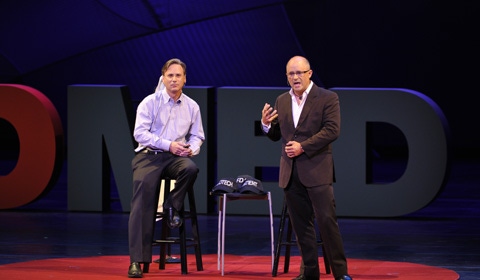“We must reconsider, we must redefine, and we must recalculate what is acceptable risk."--Jonathan Glass, director of the Emory ALS Center
April 13, 2012

A price tag can’t be placed on the courage and determination of those who spend endless hours trying to develop treatments for incredibly debilitating and incurable conditions. Yesterday, two crusaders against ALS took the stage at TEDMED to talk about their work in stem cell transplantation to improve the lives of patients with this disease.
|
(left to right) Jonathan Glass and Nick Boulis at TEDMED. |
“Every day I see people with an incurable disease. That disease is called amyotrophic lateral sclerosis, or ALS. There are no survivors of this disease, and I have really nothing to offer my patients, except for compassion, palliative care, and the promise that every day I’ll look for both the cause and the cure for their disease,” said Jonathan Glass, MD, director of the Emory ALS Center, department of neurology at Emory University. “The hope is that the extraordinary innovation in science and technology will lead to new treatments for ALS and other degenerative diseases of the nervous system.”
Glass shared the stage with Nick Boulis, MD, founder of the Boulis Laboratory at Emory University School of Medicine.
He talked about their involvement in a new potential treatment for ALS via injecting stem cells into the spinal cord to preserve neurological function. So far stem cells have been safely injected into 14 ALS patients. One of the most exciting parts of his work with Boulis is that he is part of a bigger trend, as research teams worldwide are developing cell types for work in clinical trials.
But—and it’s a big obstacle in the area of stem cell work—regulatory hurdles stand in the way.
“We have every reason to believe that with collaboration and with the experience gained with trial and error, we’ll be able to provide an effective therapy for people with ALS,” said Glass. “But that effort is being hampered by a regulatory system that really is built to minimize risk—even if it stifles innovation.”
Glass had one clear message for the audience: “We must reconsider, we must redefine, and we must recalculate what is acceptable risk. And that risk must fit the emerging technologies and emerging therapies that hold the enormous potential to transform the treatment of disease in the practice of medicine.”
Maria Fontanazza is managing editor at UBM Canon Media Group. Follow her on Twitter: @MariaFontanazza
About the Author(s)
You May Also Like



